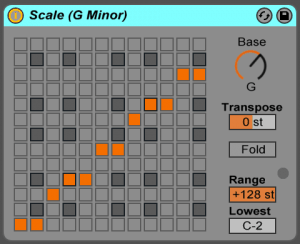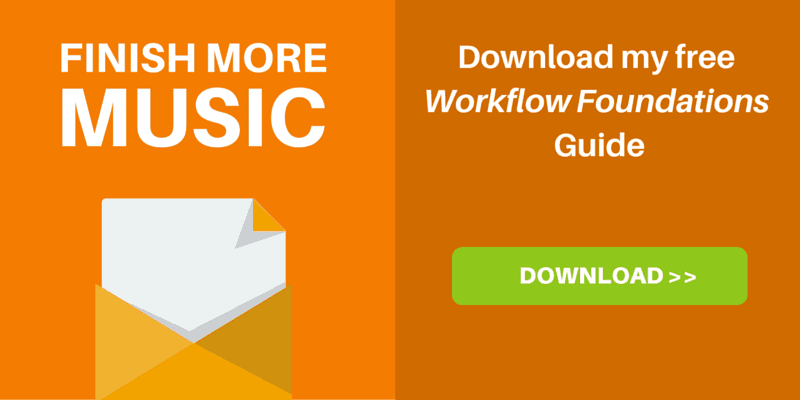“All your ideas may be solid or even good..but you have to actually execute on them for them to matter.” – Gary Vaynerchuk
The above quote is 100% true. Ideas mean nothing if you don’t develop them.
But what if you can’t come up with ideas in the first place? After all, you can’t execute on something that doesn’t exist.
And let’s not pretend that all music producers have a constant stream of ideas flowing into their heads. For some that’s true, but for many – it isn’t.
In fact, one of the most common questions I get from producers is…
“How do I come up with ideas for songs?”
So I decided to put together this list of 37 ways to discover new ideas for songs.
Note: if you know of a way that isn’t included in this list, leave a comment with your way and I’ll add it to the list.
1. Play an instrument
A change in environment sparks creativity.
If you play an instrument, but hardly ever touch it, now is the time to do so. Sticking your head further into your DAW is not going to help you come up with ideas, so get out of the box and jam.
2. Use your MIDI keyboard
I can’t even play keyboard. I put my fingers in the wrong place and hit the wrong notes all the time. But 90% of all my tracks start on a cute little 25-key MIDI keyboard.
Not sure how to come up with ideas on a MIDI keyboard? Start hitting some notes until you come across something cool (if you’re really stuck – just hit the white keys. You can’t go wrong.)
3. Use Ableton’s Scale device
 If you have a complicated relationship with music theory – that is, you always put off learning your scales – then Ableton’s scale device is a great solution.
If you have a complicated relationship with music theory – that is, you always put off learning your scales – then Ableton’s scale device is a great solution.
Why?
Because when you’re trying to come up with ideas, the last thing you want to think about is what notes you need to use. Ableton’s scale device will stop you from hitting the wrong notes.
You’re not cheating if you use this tool, you’re being smart. That’s why these things are made.
4. Lay down the drums first
C’mon. You don’t need a spark of inspiration to lay down a drum section.
Set up a 4 to 8-bar loop containing a bunch of drum and percussion sounds, and then wait to see if anything enters your head.
Usually it will, simply because it’s easier to imagine ideas when there’s a backdrop in place compared to a blank canvas.
This leads me to my next point…
5. Go through the motions
I envy the producer who frequently gets gifted ideas while doing day-to-day tasks (eating, having a shower, etc.)
It’s easy to think that you need an idea in your head before starting a project. That you need to wake up some day humming a brilliant melody.
But this isn’t how it works for some people. In fact, I’m not sure if I’ve ever made a song with an idea that came to me outside of a production session.
Instead of waiting around for the idea to come to you, take action. Go through the motions: open your DAW, set up your project, add structure markers, lay down some drums. I guarantee you’ll come up with something.
6. Use another track as a starting point
My first ever signed remix came together in a matter of hours after being inspired by an electro-trance tune I’d bought a few weeks earlier.
How?
Well, I needed to remix a track for this label, but nothing was coming to me. I tried, but as I tried I became more stressed.
So, I dragged the electro-trance tune into my DAW, and literally copied the intro hit for hit (using different samples, of course).
After the first 8 bars, I had a ton of ideas for my remix, which ended up sounding completely different to the track I used as a starting point.
7. Use an older project as a starting point
Noah Neiman talks about this in his interview on the EDM Prodcast.
He’ll open up an older project and use it as a template for a new project, saving him A LOT of time (which I imagine is helpful considering he’s a doctor as well as a successful producer).
But beyond the workflow benefits, this trick can be used to generate new ideas. You could lower the tempo and change the main instrument, for instance, resulting in a stream of fresh ideas.
The key isn’t to make something similar to the old project, but rather use it as a palette for new ideas (instead of starting with nothing).
8. Save your projects properly
Wait…what?
How does saving your projects properly lead to new ideas?
It’s simple.
You’ve probably worked on a project where you felt you could have gone in a few different directions. You could have used a different drum pattern, changed the lead sound, made a significant change to the arrangement.
Well, because creativity benefits from experimentation, it pays to actually follow these different directions to see where they lead. Some of the directions you go down will end up sounding terrible, and you’ll want to backtrack, which is why you need to save properly.
Here’s how…
Filename: nameofsong_draft.als
This is your core project file. The file you use from the start until you reach the point where you’re presented with various possible paths.
You decide to change the melody to something a little darker, so you change your project file to…
Filename: nameofsong_darkmelody.als
As you try out the ideas presented to you, and save as a new version each time, you’ll end up with a few different versions. You’ll choose to pursue one of these (hopefully), but the others can be used as a basis for new songs.
TL;DR: Save as a new version every time you do something significant. Non-final versions can be used as a basis for new tracks.
9. Use themes
I learned this technique from Jaytech during his value-packed masterclass at Pyramind.
I use this technique in two ways. The first way is to generate my own set of themes. If I’m starting a new trance track, the themes might be:
- Medium tempo (around 130BPM)
- Dark and groovy. Uses swing.
- Crunchy/processed vocal chops
- Crisp/clean drums
- Smooth, low-mid-only bassline
- Evolving sounds
These themes help provide a vision of how the track’s going to sound when finished, which gives me something to work from. Of course, given the nature of creativity, the project diverts wildly from the original themes. But that’s half the fun.
If you can’t come up with any themes, or you want to try out a genre you’re not well accustomed with, then you can follow the same process Jaytech does:
- Go to the Beatport Top 10 chart for your desired genre
- Listen through and write down a bunch of themes that stand out to you
- Produce based on the themes you’ve written down
By the way, I also interviewed Jaytech on the EDM Prodcast. You can listen to our discussion here.
10. Preset scrolling
This is an underrated technique.
It’s also not complicated AT ALL.
Pick your favorite synth and scroll through presets while jamming on your MIDI keyboard. You don’t need to buy preset packs either, as most synths have a ton of great presets already (have you heard some of Spire’s presets? Wow.)
11. Sample scrolling
You can scroll through samples the same way you can scroll through presets. Eventually you’ll come across something that sparks an idea for a song.
It pays to scroll through the right samples, though. If you’re just browsing through drum hits, you probably won’t find anything that generates an idea. Vocal chops and synth hits will be more likely to spark something.
12. Remove the pressure
“During pre-production, [Rick] Rubin tries to steer his artists away from the distraction and pressure of the Hollywood spotlight and striving for commercial success.” – Jake Brown, Rick Rubin in the Studio
This isn’t as much a technique as it is a mindset.
If you feel pressured to make something great, to impress others–if you feel you must make a masterpiece, then you’re not going to come up with ideas.
And even if you do, you’ll ignore most of them because they don’t fit your unreachable standard.
Ideas benefit from a relaxed environment. Focus on the music, not what it will necessarily do for you and your career.
13. Design sounds
This goes hand-in-hand with preset scrolling.
When you spend time designing sounds, you invariably hear surrounding elements pop into your head.
If you’re designing a bass sound, you might hear some drums. If you’re designing a pluck sound you might hear a melody pop into your head.
Even if you don’t come up with any ideas, your time hasn’t been wasted as you’ve (hopefully) designed some great sounds.
14. Remix
This one’s obvious, but it works.
When you remix another track, the ideas are already there for you. You don’t need to write a new chord progression or melody, and in some cases it’s a good idea to keep the original composition intact.
15. MIDI files as a starting point
Before you get all up in arms and tell me that using MIDI files is cheating, don’t worry, I agree.
I don’t have a huge amount of respect for producers who use construction kits, unchanged, to create a track and then release it.
But using a construction kit or MIDI file as a starting point for something new is a great way to come up with new ideas, especially if you’ve been going through a dry patch.
16. Collaborate
Collaboration helps idea generation in a few ways:
- You’ve got two minds attempting to generate ideas compared to just one
- You can bounce ideas off each other, ultimately refining them.
- Each person feels a heightened sense of responsibility, meaning laziness won’t be the cause of a lack of ideas.
17. Use a new plugin
I’ll preface this way by saying that downloading new plugins frequently is a bad habit. It can lead to analysis paralysis, and besides, no one needs 100 subtractive synths.
But if you are stuck, downloading a new synth or audio effect can help with idea generation, even if it’s just for the presets.
18. Blindly process
If you ever feel like you’re taking music production too seriously – do this:
- Insert a synth with a basic patch (I like to use the init patch, but you can use anything)
- Create a simply rhythm or melody (it can literally just be one note if you like)
- Start adding audio effects with the aim to completely mangle and change the sound. I recommend using Max for Live audio effects.
Most of the time you do this you’ll end up with something that sounds ugly, but you’ll have had fun doing it, and you’ll have likely come across an idea for a track.
19. Use a visual
As you already know, there’s a strong link between visual and audio. That’s why films are so engaging, they make use of both.
You can use a visual to come up with ideas for a song. Consider:
- Writing to your favorite scene from your favorite film
- Creating a song around a landscape photo that inspires you
- Drawing a line on a piece of paper and composing a melody that follows it (read more about this process)
20. Learn a new technique
The first uplifting trance track I made happened because I wanted to learn how to program a rolling bassline.
Watching YouTube tutorials and learning new techniques almost always lead to new song ideas, so if you’re stuck, spend some time learning.
21. Do what you know
I almost left this one out, because it’s dangerous.
Experimentation is a much better way to come up with new ideas, but sometimes, when you spend all your time experimenting, you feel like you’re a bit out of your depth.
And being out of your depth is not a good space to be in if you want to generate new ideas.
So, if you are in that position, stick to what you know. If you know how to make a killer rolling bassline or groovy tech house drum loop – do that.
Note: as I said, this one is dangerous. If you always stick to what you know, you’re not going to pick up anything new, and eventually your creativity will stagnate which will lead to a lack of ideas.
22. Steal ideas from other genres
This one’s super easy.
Listen to a genre you don’t normally like and use one of the key characteristics of that genre in another.
For example, progressive trance music often uses a monophonic, harsh-sounding lead (like the one in Lost Connection by Jochen Miller at 3:20). You could take this sound and use it in a drum ‘n’ bass track. Not the exact melody, but the style and sound.
23. Keep it simple
This relates to removing pressure.
You don’t have to come up with the most amazing, complex idea. In fact, simple ideas often work better.
Take Fifth Harmony & Ty Dolla $ign’s Work from Home as an example. The riff that plays throughout is incredibly simple, but it works.
24. Forget making a “song”
It can be overwhelming thinking about everything involved in creating a song. Sometimes, it inhibits us from coming up with ideas because we know how much work there is to do afterwards.
Tell yourself that all you need to do is come up with one idea. Don’t pressure yourself into making a full song. When that pressure is gone, it’s much easier to come up with ideas because you don’t feel obligated to develop them.
Think about this as building up your “ideas bank.” You create a melody, store it in a folder called “melodies,” and you may come back to it later if you feel inspired.
25. Write around a vocal
Get your hands on an acapella (look for remix competitions if you can’t find any), drag it into your DAW, and write something that fits underneath it.
I do this often if I don’t feel like writing from scratch. Working around a vocal means you have limitations in place, which can make idea generation easier than if you have little or no limitations.
26. Start with the rhythm
I don’t know about you, but I find it A LOT easier to come up with a solid groove than a melody.
If you’re the same, it might pay to start that way. Figure out how the kick and bass are going to interact in your song. Make them sound tight. Then worry about the melodic content.
27. Motif then melody
Coming up with a good melody is hard.
So, instead of trying to write a great melody from the start, focus on writing a simple motif.
What’s a motif? According to Wikipedia, it’s “a short musical idea…musical fragment or succession of notes that has some special importance in or is characteristic of a composition.”
So, just write a few notes. You can then use your motif as a basis for a fully-fledged melody.
28. Go to an event
As I mentioned earlier, a change in environment sparks creativity.
So, if you haven’t gone out in a while, consider going to a festival or club event to re-ignite the fire. You’re bound to come home full of new ideas.
29. Chop up a vocal
If you’re an Ableton user, your life has been made easy.
Right-click on a vocal loop or acapella in your playlist and click “Slice to new MIDI track.”
Make sure the slice setting is on transient, and then click okay.
BOOM. You now have a drum rack with a bunch of vocal chops. Play a bunch of them on your keyboard until you come across something awesome.
30. Use iterative production
I cover this in detail in the upcoming second edition of The Producer’s Guide to Workflow & Creativity, but the basics are as follows:
- Write a super basic idea. It could be one chord playing a rhythm.
- Duplicate the track, and make an improvement – e.g., add a second chord to the progression.
- Keep iterating until you’re satisfied.
This may seem pedantic to you, but it has a purpose. It reduces overwhelm and gives you no reason not to get started.
31. Emulate someone else
Try to emulate one of your favorite artists and make a song in their style. I don’t mean remaking one of their tracks, but rather copying their sound.
32. Force it (the timer method)
This one isn’t for the faint-hearted, but it normally works.
People assume you can’t force creativity, and there may be some truth to that, but successful artists of the past will be the first to tell you that sometimes, you just have to sit down and push through the resistance.
So, if nothing else is working, set a timer. Don’t make it too long. 30-60 minutes is fine.
Force yourself to sit there and come up with something during that time. Don’t leave your chair until the timer is up. Chances are, you’ll come up with something okay that can be developed into something decent.
But Sam, what if I don’t come up with anything good?
Don’t worry about it. That’s part of the process. Cut your losses and try again tomorrow.
33. Listen to more music
This is less a “way” than it is a necessity.
I find it odd that some producers brag about the fact they listen to hardly any music.
“Oh, you know, I like to be original and creative. I don’t listen to any music because it will influence my creations too much.”
Stop kidding yourself.
Sure, pure consumption without any production is useless if you’re an artist, but there does need to be a high degree of consumption.
You’ll know how powerful this is if the following has happened to you…
…you’ve had a rough week. You’ve tried to sit down and make music but nothing came to you.
You’re feeling like you’re not cut-out for the job. You don’t feel inspired in the slightest.
All of a sudden, you hear a new song on your Spotify playlist. You haven’t heard it before, but you’re immediately impressed. You get excited… and the next minute – you’re in the studio starting a new project.
Read: The Necessity of Intention Listening
34. Cultivate consistency
One reason producers find it hard to come up with new ideas is that they aren’t consistently making music every day.
Take exercise as an example.
If you’ve ever had a break from exercising, whether it’s cardio or lifting weights, and you start up again, you know that the first day you “restart” is tough. You’ve lost strength, fitness.
And it’s similar with music, or any creative discipline for that matter. You become rusty. You aren’t used to it, and it’s hard to restart.
By staying consistent, your subconscious is constantly working on new ideas for you.
35. Record something
I mentioned earlier that a change in environment often leads to creative ideas.
Getting “out of the box” is one way to change your environment, even if it’s on a micro-level.
Buy a mid-range field recorder (I use the Zoom H4N) and start recording a bunch of stuff. Make your own sample pack.
A few ideas:
- Head to the beach and record the sound of waves crashing
- Sit in a cafe and press record. Soak up the atmosphere and use it in a track.
- Record kitchen utensils, pots and pans to use as samples.

36. Use paper
“There’s just something about paper and pen and sketching out rough ideas in the ‘analog world’ in the early stages that seems to lead to more clarity and better, more creative results when we finally get down to representing our ideas digitally…” – Garr Reynolds
I’ve recently been reading a book called The Presentation Secrets of Steve Jobs by Carmine Gallo.
One of the first sections in the book talks about the importance of planning in analog. That is, with paper or on a whiteboard.
Sketch out ideas for a track. How does one section flow into the next? Use key words, create diagrams, draw arrows, exercise creativity and thought.
37. Live production
If you’re an Ableton user and have a MIDI keyboard, you can do this.
Set up an 8-bar basic drum loop in session view and start recording stuff over the top.
Improvise. Don’t analyze.
Pretend you’re actually playing live and adding new stuff.
Note: standing up helps with this.
Conclusion
There you have it. 37 ways to come up with new ideas.
So, next time you complain about your lack of inspiration or that you have creative block, read this post, pick an idea, and get to work.
Want to know how take ideas and turn them into a full song? Download my free Workflow Foundations guide by clicking the image below.
[x_author title=”About the Author”]


